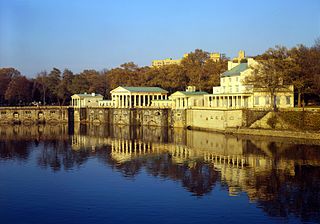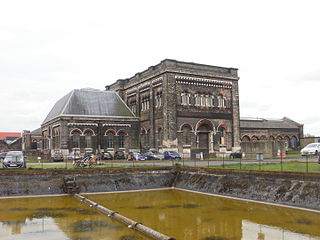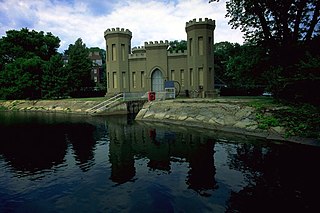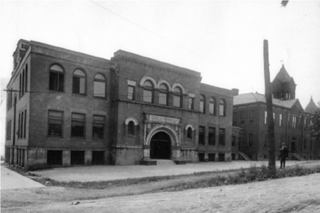
The Fairmount Water Works in Philadelphia, Pennsylvania, was Philadelphia's second municipal waterworks. Designed in 1812 by Frederick Graff and built between 1812 and 1872, it operated until 1909, winning praise for its design and becoming a popular tourist attraction. It now houses a restaurant and an interpretive center that explains the waterworks' purpose and local watershed history. It was designated a National Historic Landmark in 1976 for its architecture and its engineering innovations. It was the nation's first water supply to use paddle wheels to move water.

The Crossness Pumping Station is a former sewage pumping station designed by the Metropolitan Board of Works's chief engineer Sir Joseph Bazalgette and architect Charles Henry Driver. It is located at Crossness Sewage Treatment Works, at the eastern end of the Southern Outfall Sewer and the Ridgeway path in the London Borough of Bexley. Constructed between 1859 and 1865 by William Webster, as part of Bazalgette's redevelopment of the London sewerage system, it features spectacular ornamental cast ironwork, that Nikolaus Pevsner described as "a masterpiece of engineering – a Victorian cathedral of ironwork".

The Allegheny County Courthouse in downtown Pittsburgh, Pennsylvania, is part of a complex designed by H. H. Richardson. The buildings are considered among the finest examples of the Romanesque Revival style for which Richardson is well known.

Papplewick Pumping Station, situated in open agricultural land approximately 3 miles (4.8 km) by road from the Nottinghamshire village of Papplewick, was built by Nottingham Corporation Water Department between 1881 and 1884 to pump water from the Bunter sandstone to provide drinking water to the City of Nottingham, in England. Two beam engines, supplied with steam by six Lancashire boilers, were housed in Gothic Revival buildings. Apart from changes to the boiler grates, the equipment remained in its original form until the station was decommissioned in 1969, when it was replaced by four submersible electric pumps.

Mount Crosby pumping station is a heritage-listed pumping station and weir at Stumers Road, Mount Crosby, City of Brisbane, Queensland, Australia. It is located on the Brisbane River and extends into Chuwar on the other side of the river. The facility supplies water to Brisbane and nearby cities and towns within the SEQ Water Grid. It was originally designed by Charles H McLay and built from 1891 to 1892. The historic parts of the facility were added to the Queensland Heritage Register on 25 October 2019. It is also listed on the Brisbane Heritage Register, together with numerous associated facilities which were not included in the state heritage listing.

Immaculate Heart of Mary Church in Pittsburgh, referred to in Polish as Kościół Matki Boskiej, is a historic church of the Catholic Diocese of Pittsburgh. Located on Polish Hill in Pittsburgh, Pennsylvania, it is a prime example of the so-called 'Polish Cathedral' style of churches in both its opulence and grand scale. The church was designated a historic landmark by the Pittsburgh History and Landmarks Foundation in 1970.

College Hill is a neighborhood of the City of St. Louis, Missouri. The name College Hill was given to this area because it was the location of the Saint Louis University College Farm. This area, bounded generally by Warne Ave., O'Fallon Park, I-70, Grand Boulevard, and W. Florissant Ave., was acquired by the University for garden and recreation purposes in 1836. It was subdivided in the early 1870s.

Walka Water Works is a heritage-listed 19th-century pumping station at 55 Scobies Lane, Oakhampton Heights, City of Maitland, New South Wales, Australia. Originally built in 1887 to supply water to Newcastle and the lower Hunter Valley, it has since been restored and preserved and is part of Maitland City Council's Walka Recreation and Wildlife Reserve. It was added to the New South Wales State Heritage Register on 2 April 1999.

Castle Gatehouse, Washington Aqueduct is a pumping station at the Georgetown Reservoir on the Washington Aqueduct in The Palisades neighborhood of Washington, D.C., United States. The building is on the National Register of Historic Places and contributes to the Washington Aqueduct National Historic Landmark.

The Minne Lusa Pumping Station was located along John J. Pershing Drive in the Florence neighborhood of North Omaha, Nebraska. The station, which was surrounded by settling basins, was the main source for pumping, filtering, and distributing Missouri River water throughout the City of Omaha. The station was the namesake of the Minne Lusa neighborhood located immediately to the south.
The Pittsburgh Water and Sewer Authority (PWSA) is a municipal authority in Pittsburgh, Pennsylvania. It is responsible for water treatment and delivery systems in the city of Pittsburgh, as well as the city's sewer system. In a 2010 report, the authority reported 80,557 drinking water service connections and 107,151 sewage connections. The authority claims to serve approximately 83,000 customers.

The Spring Hill Elementary School is located at 1351 Damas Street in the Spring Hill neighborhood of Pittsburgh, Pennsylvania. The building was first constructed in 1896 in the Classical Revival style and serves as the elementary school for residents of the Spring Hill area.

Goulburn Pumping Station is a heritage-listed former municipal water supply system and now museum at Wollondilly River, Goulburn, Goulburn Mulwaree Council, New South Wales, Australia. It was built from 1885 to 1886. It includes the historic Appleby Steam Engine, which is contained in the pumping station.

The Ryde Pumping Station is a heritage-listed pumping station and offices located at Victoria Road, West Ryde, New South Wales, Australia. It was built from 1891 to 1921 by William Adams & Co. Ltd., State Monier Works, Refshaw & O'Brien. It is also known as Ryde Pumping Station and site, WP005 and West Ryde Pumping Station. The property is owned by Sydney Water. It was added to the New South Wales State Heritage Register on 15 November 2002.

Burnt Mills is an census designated place in Montgomery County, Maryland, United States. Per the 2020 Census, the population was 3,592.

The Waterworks Museum is a museum in the Chestnut Hill Waterworks building, originally a high-service pumping station of the Boston Metropolitan Waterworks. It contains well-preserved mechanical engineering devices in a Richardsonian Romanesque building.

The former Jones and Laughlin building is located at 200 Ross Street in the Downtown neighborhood of Pittsburgh, Pennsylvania. Built in 1907 in the Jacobean Revival architectural style, the building served as the headquarters of the Jones and Laughlin Steel Company from its construction until 1952 and currently holds offices for various governmental agencies in the City of Pittsburgh. It was designated a City of Pittsburgh Historic Landmark in 2020 and was listed on the National Register of Historic Places in 2021.

Preservation Pittsburgh is a non-profit advocacy group founded in 1991 to support the preservation of historic, architectural, cultural, and environmental sites and buildings within Pittsburgh, Pennsylvania.

Omohundro Water Treatment Plant is a municipal water treatment plant located in Davidson County, Nashville, Tennessee on Omohundro Drive.

William Smith Fraser (1852–1897) was an American architect based in Pittsburgh, Pennsylvania. Fraser is best known for his designs for the Herron Hill Pumping Station (1896), a City of Pittsburgh Historic Structure, and the original Joseph Horne Company Department Store (1893), a Pittsburgh History and Landmarks Foundation Historic Landmark, though substantially rebuilt by later architects.


























